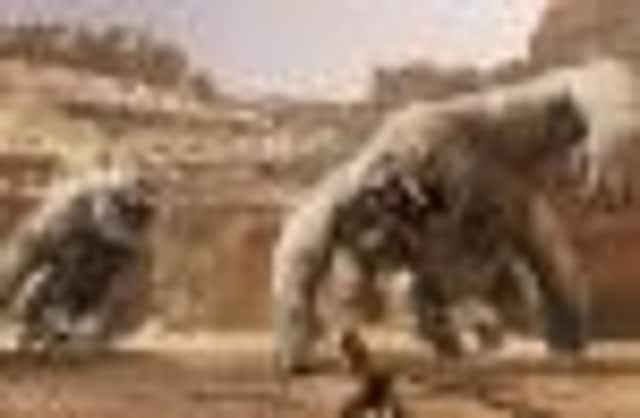Film review: John Carter


More Stargate than Star Wars, there’s a distinctly underwhelming vibe to this once much-fancied adaptation of Tarzan creator Edgar Rice Burroughs’s century-old, multi-volume sci-fi adventure saga. It marks the live action debut of Wall-E director Andrew Stanton, who seems to have been overwhelmed by the task of bringing such an expansive blend of old-fashioned derring-do, hokey mythology and cutting-edge special effects to the big screen. There’s certainly none of the narrative nimbleness or compelling emotional hooks one might expect from someone schooled at Pixar. And while it’s hardly the sci-fi Heaven’s Gate some of the pre-release horror stories of ballooning budgets, extensive reshoots and contentious title changes suggested it was going to be, the somewhat bloated and clunky end result isn’t likely to silence the naysayers.
It’s a shame, because things do start off reasonably well. Even leaving aside the distracting dimness of the post-production 3D conversion (why bother?), Stanton and co-writers Mark Andrews and Michael Chabon (the Pulitzer-winning author of The Amazing Adventures of Kavalier & Clay) seem to have a good sense of who their titular hero is and how to introduce him. A widowed civil war veteran and inveterate fighter, John Carter is a roguish, reluctant hero in the Indiana Jones mould and the little-known Taylor Kitsch seems like he has the confidence and the charisma to play him as such. His first few scenes, in which he repeatedly attempts to avoid being press-ganged into military service for the Confederate army, certainly have just the right mix of self-awareness, humour and sincerity to make the prospect of spending another couple of hours with him seem like a pleasurable experience.
Advertisement
Hide AdUnfortunately he’s then transported – via a hazily explained gizmo – to a civil war on Mars and proceeds to spend practically the entire movie resisting the inevitable call to action. Needless to say, this makes the character an insufferable bore. With his bone density – or something – giving him the superhero-like ability to bound hundreds of feet through the air (he’s like a svelte, hunkier Incredible Hulk), there are only so many times it’s possible to sit through him leaping to the rescue of some multi-limbed Martian before his repeated reluctance to fight for their cause starts feeling like a plot-padding way to extend the running time.
Consequently the film gets bogged down by the overly convoluted mythology cooked up to explain why a Machiavellian race of mystics led by a shape-shifting Mark Strong is trying to engineer a planet destroying war between – deep breath – the super-weapon-wielding wannabe conqueror Sab Than, Prince of Zodanga (Dominic West), and the philosophically minded imperial natives of Helium, led by a beautiful red-skinned princess called Dejah Thoris (played by True Blood’s Lynn Collins). And that’s before we even get to how the Tharks – the nomadic, nine-foot-tall creatures who imprison then adopt Carter – figure in all this.
Of course, the prospect of seeing all the creatures Edgar Rice Burroughs envisioned 100 years ago come to life on the big screen with the anything-is-possible technology available to modern blockbuster filmmakers should be among the film’s biggest pleasures. Alas, the ubiquity of more than three decades worth of Star Wars-inspired sci-fi movies has stolen much of John Carter’s thunder, to say nothing of the debilitating impact the similarly themed Avatar has on it.
Sadly, Stanton doesn’t seem able to even build on Avatar’s technological breakthroughs. As dispiriting as the success of that movie was, at least Cameron’s use of motion capture technology gave his alien creatures expressive faces and distinctive personalities. That development, together with the evolutionary leap forward that Andy Serkis’s work in Rise of the Planet of the Apes took last year, should have made the Tharks in John Carter something truly special. But they’re not. Or at least, the actors’ performances haven’t been translated into anything especially memorable. Samantha Morton, for instance, is so lacking in presence I had to check the credits to see if she provided anything more than the rather anonymous sounding voice for Carter’s main Thark ally, Sola. Willem Dafoe and Thomas Haden Church don’t fare much better.
The action sequences don’t help matters either. They’re too chaotic, have no sense of rhythm and, in the 3D version, tend to merge into one big, indistinguishable motion blur. Even when Stanton attempts to cross-cut one key sequence with flashbacks from the hero’s tragic past, the pathos is ruined by having a rather silly looking dog-like critter tear through the battle scene like the Tasmanian Devil.
It’s too bad because there’s so much talent involved, and so much money and energy expended on bringing this to the big screen that its inability inspire more than an indifferent shrug makes it all the more disappointing.
• John Carter (PG)
Directed by: Andrew Stanton
Starring: Taylor Kitsch, Lynn Collins, Samantha Morton, Willem Dafoe, Thomas Haden Church
Rating: **